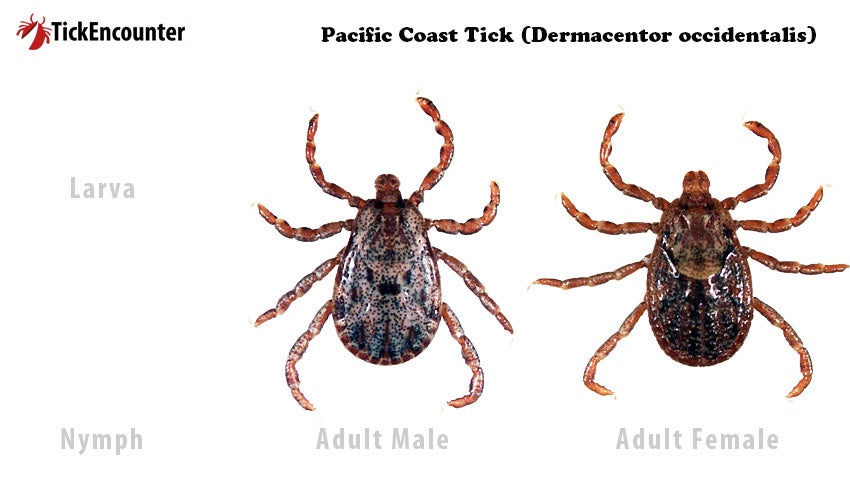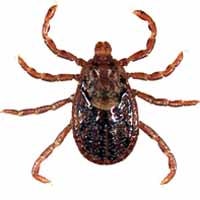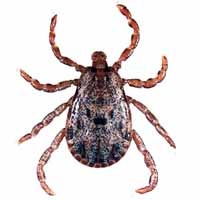
Overview
Pacific Coast ticks are human-biting ticks with a broad host range, found predominantly in shrublands, chaparral, and along trails from Oregon to northern Baja California and Mexico. Pacific Coast ticks are the most common tick found nearly throughout California but are easily confused with other less common Dermacentor ticks found along the western coastal regions of the U.S (D. variabilis, D. andersoni, D. albipictus). All life stages of this tick can transmit Rocky Mountain spotted fever (Rickettsia rickettsii) to humans, cats, and dogs. Nymphs and adults can transmit 364D rickettsiosis (Rickettsia phillipi) to humans, tularemia (Francisella tularensis) to humans, cats, and dogs, and bovine anaplasmosis to cattle. These ticks also have been implicated in cases of tick-bite paralysis in cattle, deer, and ponies.
Field Notes
Adult males and females Pacific Coast ticks may be active year-round but peak activity typically occurs during cooler months, and especially in April and May. Adults prefer to feed on cattle, horses, deer and other large mammals but they readily attack dogs and people. The males attach and feed for short periods of time to initiate sperm production, but females feed for 6-10 days before dropping off their host and laying eggs. Eggs are laid about 3 weeks after the engorged adult detaches. Larvae and nymphs of Pacific Coast ticks rarely attack humans or pets.
Update: Up to 11% of adult Pacific Coast ticks carry the spotted fever group rickettsia Rickettsia phillipii. This germ is associated with the formation of a cutaneous lesion called an eschar as well as Pacific Coast tick fever, and infection with R. phillipii can be mistaken in diagnostic tests for the more dangerous Rocky Mountain spotted fever.
Life Cycle Stages
Adult Female
 Top
TopPacific Region
Encounter Risk
JanFebMarAprMayJunJulAugSepOctNovDecKnown Diseases Transmitted
- Colorado Tick Fever
Colorado tick fever virus
- Pacific Coast Tick Fever
Rickettsia philipii, formerly Rickettsia 364 D (bacteria)
- Rocky Mountain Spotted Fever
Rickettsia rickettsii (bacteria)
- Tularemia
Francisella tularensis (bacteria)
Adult Male
 Top
TopPacific Region
Encounter Risk
JanFebMarAprMayJunJulAugSepOctNovDecKnown Diseases Transmitted
- Colorado Tick Fever
Colorado tick fever virus
- Pacific Coast Tick Fever
Rickettsia philipii, formerly Rickettsia 364 D (bacteria)
- Rocky Mountain Spotted Fever
Rickettsia rickettsii (bacteria)
- Tularemia
Francisella tularensis (bacteria)
Larva
There are no images of this tick available.Pacific Region
Encounter Risk
No encounter data for this region at this time.Known Diseases Transmitted
No known diseases in this region at this time.
Nymph
There are no images of this tick available.Pacific Region
Encounter Risk
No encounter data for this region at this time.Known Diseases Transmitted
No known diseases in this region at this time.
